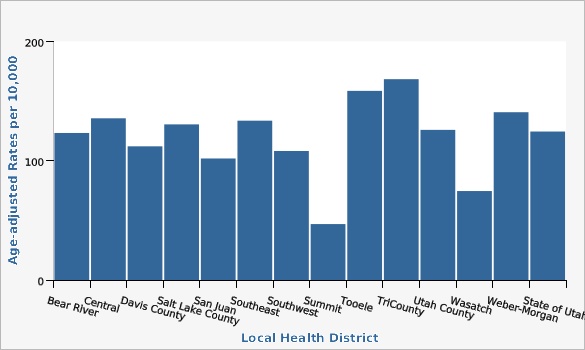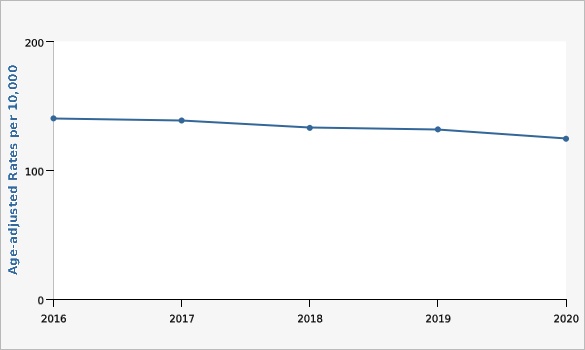Complete Health Indicator Report of Diabetes-Related Hospitalizations - All Causes
Definition
Inpatient hospital discharges with an ICD-10 code as any diagnosis that ranges between E10-E14.Numerator
Number of hospital discharges listing diabetes as any diagnosis.Denominator
All Utah residents.Data Interpretation Issues
Hospital records may contain up to 10 diagnosis codes. The first listed diagnosis is generally considered the primary reason for the hospitalization.Why Is This Important?
Diabetes is an enormous burden on the health care system. The direct and indirect costs of diabetes nationally are estimated to be at least $327 billion per year. (Centers for Disease Control and Prevention: Diabetes Fast Facts, 2020 https://www.cdc.gov/diabetes/basics/quick-facts.html).Healthy People Objective D-5:
Improve glycemic control among persons with diabetesU.S. Target: Not applicable, see subobjectives in this category
How Are We Doing?
The age-adjusted rate of hospital discharges listing diabetes as any diagnosis per 10,000 Utah population has been slowly decreasing over time. In 2020 the age-adjusted rate was 124.5 (122.0-126.9) diabetes discharges per 10,000 population, or 37,200 hospitalizations.What Is Being Done?
The Healthy Environments Active Living (HEAL) program encourages people with diabetes to enroll in a diabetes self-management education class. These classes have been shown to help individuals develop the skills they need to manage their diabetes and are usually taught by dietitians, nurses, or pharmacists, who may also hold the status of Certified Diabetes Educator (CDE). CDEs have considerable expertise in diabetes management and understand what the individual with diabetes is going through. The Utah Arthritis Program supports Chronic Disease Self-Management Programs and Diabetes Self-Management Programs throughout the state, this program is also called the Living Well with Chronic Conditions Program. This six-week program is available throughout the state at no cost and taught by community members. Information is available from Nichole Shepard, 801-538-6259, nshepard@utah.gov. More information is available on the Living Well Utah website. The HEAL program is working statewide to increase the number of locations that offer DSME and also promote DSME to eligible participants. The National DPP is also an evidence-based program to prevent type 2 diabetes. The HEAL program works with statewide partners to promote the National DPP to eligible Utahns and also is working to expand National DPP sites across the state.Evidence-based Practices
Diabetes Self-Management Classes have been shown to improve blood sugar control among participants. In Utah, programs are available that are recognized by the American Diabetes Association or certified by the American Association of Diabetes Educators. Information on classes in Utah is available on the Living Well Utah website.Available Services
The American Diabetes Association (ADA) is an excellent resource for all types of information on diabetes. Call 1-800-DIABETES or visit the website. The National Diabetes Education Program has resources for diabetes management for professionals, businesses, and patients. Most materials are available upon request at no charge. The National Diabetes Prevention Program has resources for diabetes prevention for employers, insurers, health care professionals, program providers, and individuals. The Utah Department of Health has a Health Resource hotline: 1-888-222-2542. Please call this number for information about self-management programs in Utah. The Healthy Living through Environment, Policy and Improved Clinical Care (EPICC) website provides information of diabetes self-management classes. Association of Diabetes Educators 800-338-3633 Local Chapter Facebook Page: https://www.facebook.com/aadeutah/ American Heart Association 1937 S. 300 W. #120 Salt Lake City, UT 84115 (801) 484-3838 or 1-800-242-8721Health Program Information
The Utah Department of Health Resource Line can provide information about enrolling in diabetes self-management classes. Call 1-888-222-2542 for more information. Originally known as EPICC, (The Healthy Living through Environment, Policy, and Improved Clinical Care Program), the Healthy Environments Active Living (HEAL) Program is a program within the Utah Department of Health Bureau of Health Promotion. HEAL focuses on enabling education and engaged change for public health by engaging its three main audiences: individuals, partners, and decision makers. HEAL champions public health initiatives and addresses the challenges of making health awareness and access truly universal and equitable in eight key areas: nutrition, heart health, diabetes, physical activity, schools, child care, community health workers, and worksites. The HEAL Program aims to reduce the incidence of diabetes, heart disease, and stroke by targeting risk factors including reducing obesity, increasing physical activity and nutritious food consumption, and improving diabetes and hypertension control. The primary program strategies include: Increasing healthy nutrition and physical activity environments in K-12 schools Increasing healthy nutrition and physical activity environments in early care and education (childcare/preschool) Increasing healthy nutrition and physical activity environments in worksites Improving awareness of prediabetes and hypertension for Utahns Improving the quality of medical care for people with diabetes and hypertension Improving the linkages between health care providers and supporting community programs for Utahns with diabetes and hypertension Improving access and availability to community health programs for Utahns with diabetes, hypertension, and obesity. Improving care and management of students with chronic conditions in Utah schoolsRelated Indicators
Relevant Population Characteristics
Individuals with diabetes have higher rates of hospitalization than those without diabetes across every age group. The most common reason for hospitalization among youth with diabetes is ketoacidosis. Older individuals are most likely to be hospitalized for diabetes-related cardiovascular problems.Related Relevant Population Characteristics Indicators:
Health Care System Factors
In 2020 there were 3.345 discharges from Utah hospitals listing diabetes as the primary diagnosis. The average charge for a hospital discharge with diabetes as the primary diagnosis was $18,504 (with a median charge of $11,476). People with diabetes are hospitalized for both acute and chronic complications. Many hospitalizations due to diabetes could be prevented if sufficient outpatient and self-management care is available, accessible, and obtained.Related Health Care System Factors Indicators:
Risk Factors
Many hospitalizations related to diabetes may be avoided with proper self-management and regular, routine physician visits. One of the most preventable causes of hospitalization is ketoacidosis. It is, nevertheless, the leading cause of hospitalization among youth with diabetes.Related Risk Factors Indicators:
Health Status Outcomes
Individuals with diabetes should make special efforts to seek good health. Behavioral measures, such as having an adequate amount of physical activity, eating a nutritious diet, and maintaining a healthy weight can substantially lower the risk of hospitalization.Related Health Status Outcomes Indicators:
Graphical Data Views
Hospitalization rates with diabetes as any diagnosis has been dropping since 2016.
| Age-adjusted Rates per 10,000 | Lower Limit | Upper Limit | ||||
|---|---|---|---|---|---|---|
Record Count: 5 | ||||||
| 2016 | 140.3 | 137.5 | 143.1 | |||
| 2017 | 138.6 | 135.9 | 141.4 | |||
| 2018 | 132.9 | 130.4 | 135.6 | |||
| 2019 | 131.7 | 129.1 | 134.3 | |||
| 2020 | 124.5 | 122.0 | 126.9 | |||
Data Source
Utah Inpatient Hospital Discharge Data, Office of Health Care Statistics, Utah Department of HealthHospitalization With Diabetes as Any Diagnosis (Age-adjusted Rates) by Local Health District, Utah, 2020

More rural and frontier local health districts have higher age-adjusted rates of diabetes as any cause of hospitalization.
| Local Health District | Age-adjusted Rates per 10,000 | Lower Limit | Upper Limit | |||
|---|---|---|---|---|---|---|
Record Count: 14 | ||||||
| Bear River | 123.3 | 117.9 | 128.9 | |||
| Central | 135.6 | 128.0 | 143.6 | |||
| Davis County | 112.1 | 108.4 | 115.9 | |||
| Salt Lake County | 130.5 | 127.9 | 133.0 | |||
| San Juan | 101.9 | 86.7 | 119.0 | |||
| Southeast | 133.6 | 123.3 | 144.5 | |||
| Southwest | 108.2 | 104.5 | 112.0 | |||
| Summit | 46.9 | 40.7 | 53.9 | |||
| Tooele | 158.6 | 148.6 | 169.1 | |||
| TriCounty | 168.4 | 157.4 | 179.9 | |||
| Utah County | 125.9 | 122.6 | 129.3 | |||
| Wasatch | 74.6 | 64.9 | 85.4 | |||
| Weber-Morgan | 140.7 | 136.2 | 145.4 | |||
| State of Utah | 124.5 | 122.0 | 126.9 | |||
References and Community Resources
American Diabetes Association Diabetes Prevention Program National Diabetes Information Clearinghouse Division of Diabetes Translation, Centers for Disease Control and Prevention American Association of Diabetes Educators Local Chapter Facebook Page Much of the information for this indicator was taken from the American Diabetes Association website. Information on registering for self-management prediabetes and diabetes programs can be found at http://livingwell.utah.gov/index.php. National Diabetes Education Program http://www.ndep.nih.gov National Heart, Lung, and Blood Institute http://www.nhlbi.nih.gov National Institute of Diabetes and Digestive and Kidney Diseases http://www.niddk.nih.gov Office of Disease Prevention and Health Promotion http://odphp.osophs.dhhs.gov National Hospital Discharge Report http://www.cdc.gov/nchs/data/ad/ad385.pdfMore Resources and Links
Evidence-based community health improvement ideas and interventions may be found at the following sites:- Centers for Disease Control and Prevention (CDC) WONDER Database, a system for disseminating public health data and information.
- United States Census Bureau data dashboard.
- Utah healthy Places Index, evidence-based and peer-reviewed tool, supports efforts to prioritize equitable community investments, develop critical programs and policies across the state, and much more.
- County Health Rankings
- Kaiser Family Foundation's StateHealthFacts.org
- Medical literature can be queried at PubMed library.
Page Content Updated On 01/13/2022,
Published on 03/07/2022

